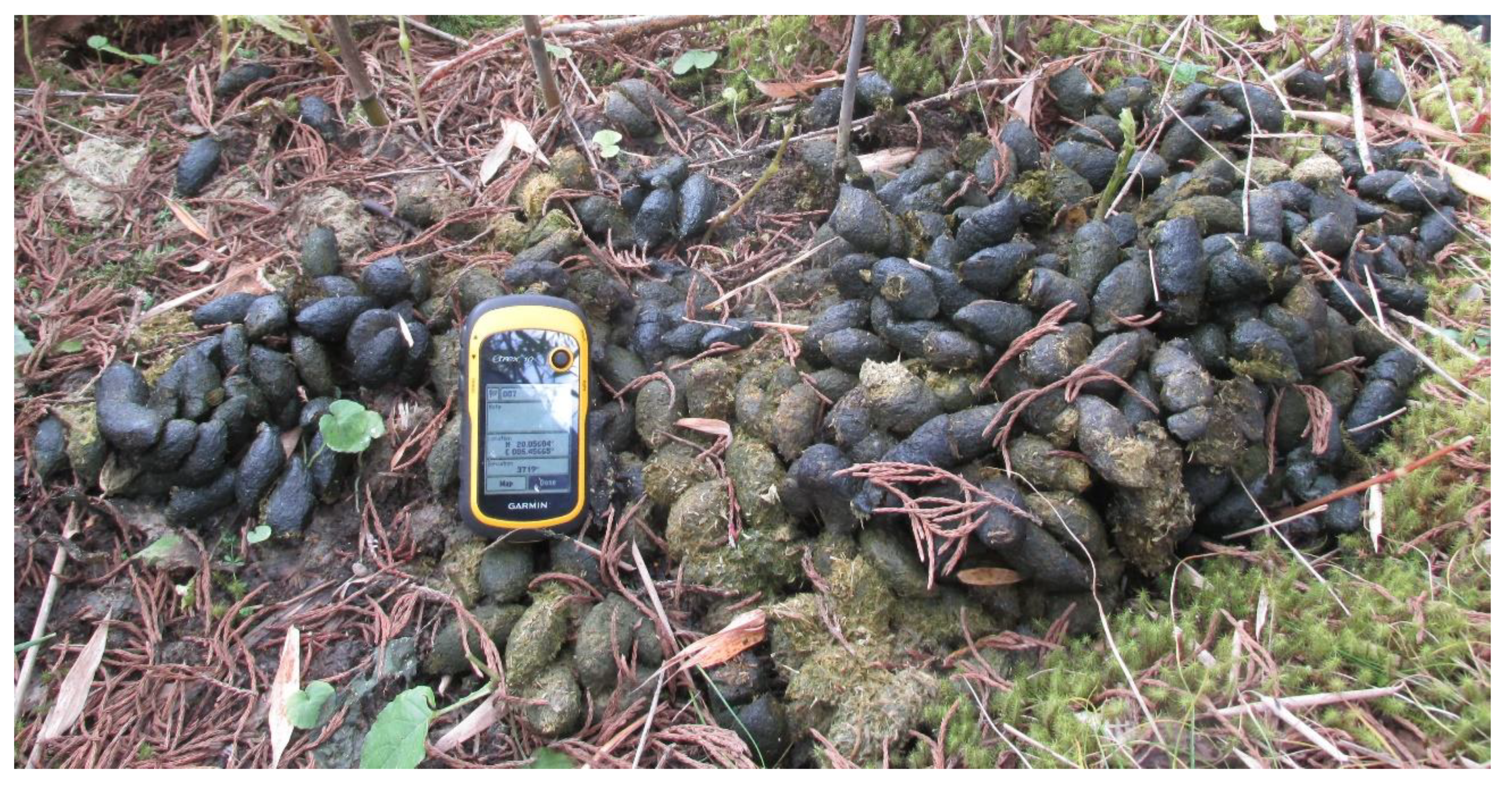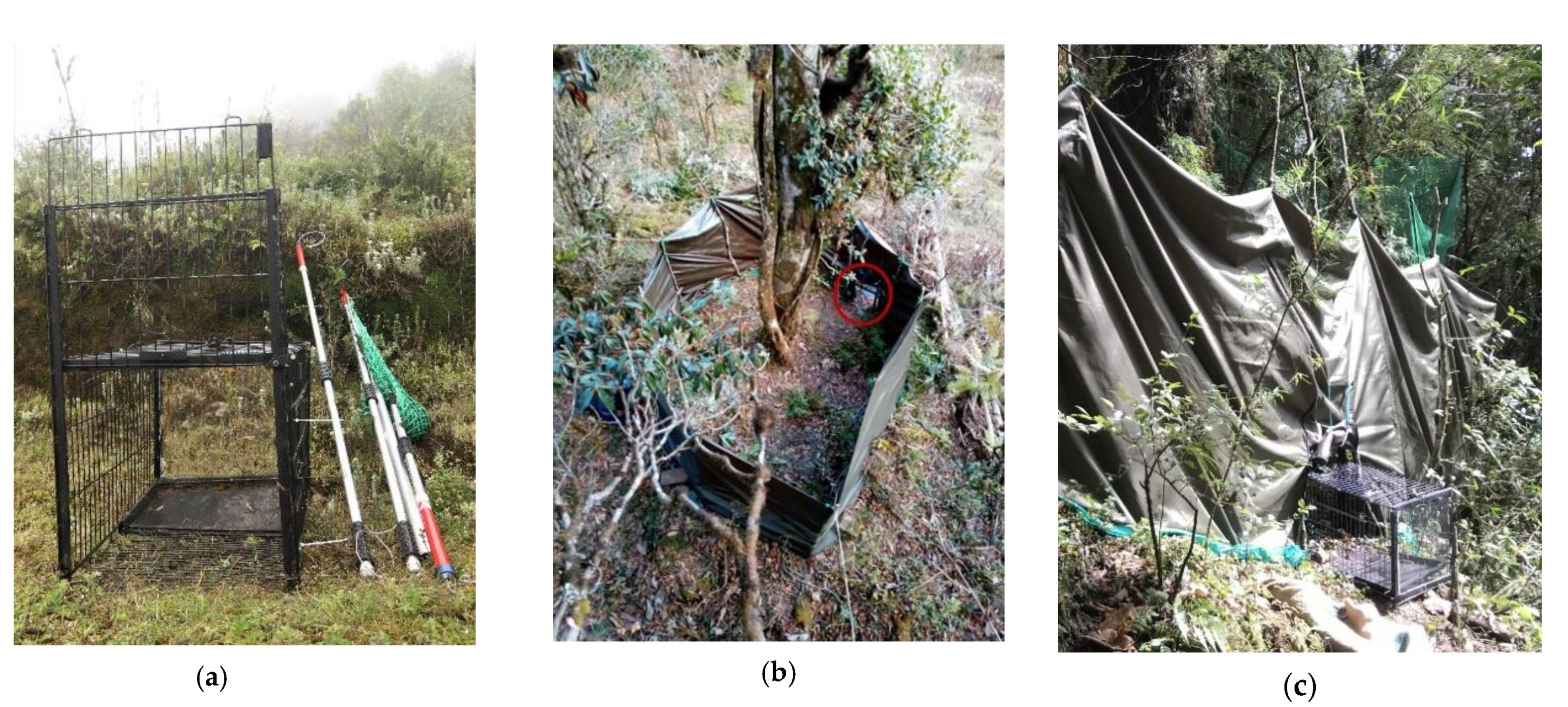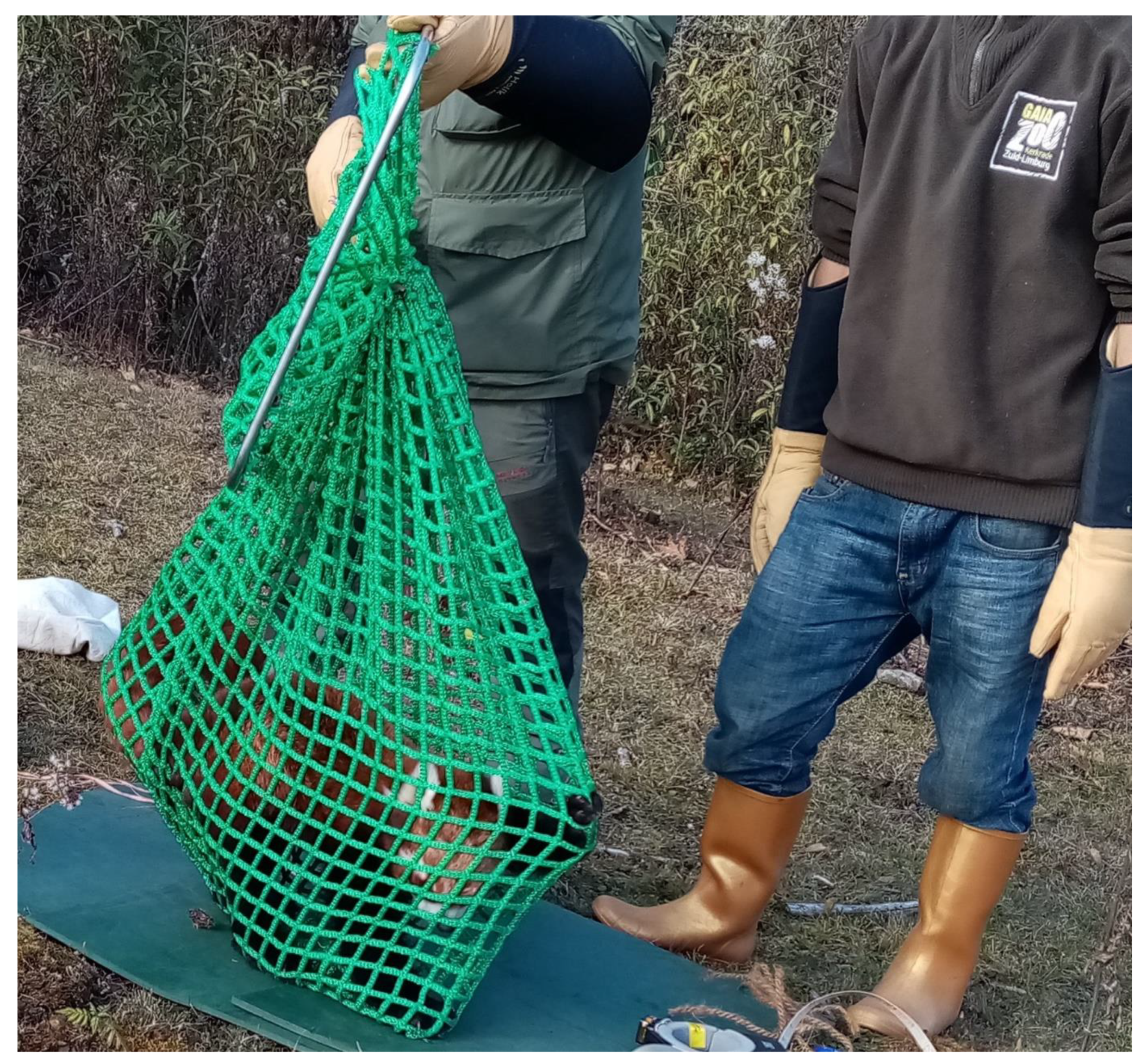Improved Trapping and Handling of an Arboreal, Montane Mammal: Red Panda Ailurus fulgens
Abstract
Simple Summary
Abstract
1. Introduction
2. Materials and Methods
2.1. Study Area
2.2. Tracking Red Pandas
2.3. Trap Design, Installation, and Trapping
2.4. Animal Handling and Immobilization
2.5. Revival and Release
2.6. Data Analyses
3. Results
4. Discussion
5. Conclusions
Supplementary Materials
Author Contributions
Funding
Institutional Review Board Statement
Data Availability Statement
Acknowledgments
Conflicts of Interest
References
- Cattet, M.; Boulanger, J.; Stenhouse, G.; Powell, R.A.; Reynolds-Hogland, M.J. An evaluation of long-term capture effects in ursids: Implications for wildlife welfare and research. J. Mammal. 2008, 89, 973–990. [Google Scholar] [CrossRef]
- Sikes, R.S.; Gannon, W.L.; Animal Care Use Committee of the American Society of Mammalogists. Guidelines of the American Society of Mammalogists for the use of wild mammals in research. J. Mammal. 2011, 92, 235–253. [Google Scholar] [CrossRef]
- Schemnitz, S.D.; Batcheller, G.R.; Lovallo, M.J.; White, H.B.; Fall, M.W. Capturing and handling wild animals. In The Wildlife Techniques Manual; Silvy, N.J., Ed.; Johns Hopkins University Press: Baltimore, MD, USA, 2009; pp. 232–269. [Google Scholar]
- Phillips, S. Development of a lightweight, portable trap for capturing free-ranging Koalas Phascolarctos cinereus. Zoologist 2011, 35, 747–749. [Google Scholar] [CrossRef][Green Version]
- Bista, D.; Shrestha, S.; Sherpa, P.; Kokh, M.; Khanal, K.; Thapa, A.; Jnawali, S. Distribution and habitat use of red panda in the Chitwan-Annapurna Landscape of Nepal. PLoS ONE 2017, 12, e0178797. [Google Scholar] [CrossRef]
- Dorjee, D.; Chakraborty, R.; Dutta, P.K. A note on the high elevation distribution record of Red Panda Ailurus fulgens (Mammalia: Carnivora: Ailuridae) in Tawang District, Arunachal Pradesh, India. J. Threat. Taxa 2014, 6, 6290–6292. [Google Scholar] [CrossRef]
- Bista, D.; Paudel, P.K.; Jnawali, S.R.; Sherpa, A.P.; Shrestha, S.; Acharya, K.P. Red panda fine-scale habitat selection along a Central Himalayan longitudinal gradient. Ecol. Evol. 2019, 9, 5260–5269. [Google Scholar] [CrossRef] [PubMed]
- Thapa, K.; Thapa, G.J.; Bista, D.; Jnawali, S.R.; Acharya, K.P.; Khanal, K.; Kandel, R.C.; Karki Thapa, M.; Shrestha, S.; Lama, S.T. Landscape variables affecting the Himalayan red panda Ailurus fulgens occupancy in wet season along the mountains in Nepal. PLoS ONE 2020, 15, e0243450. [Google Scholar] [CrossRef] [PubMed]
- Glatston, A.; Wei, F.; Zaw, T.; Sherpa, A. Ailurus fulgens. The IUCN Red List of Threatened Species 2015: E.T714A110023718. Available online: https://www.iucnredlist.org/species/714/110023718 (accessed on 5 October 2020).
- Williams, B.H. The Status of the Red Panda in Jamuna and Mabu Villages of Eastern NEPAL. Ph.D. Thesis, San José State University, San Jose, CA, USA, 2004. Unpublished. [Google Scholar]
- Pradhan, S.; Saha, G.K.; Khan, J.A. Ecology of the red panda Ailurus fulgens in the Singhalila National Park, Darjeeling, India. Biol. Conserv. 2001, 98, 11–18. [Google Scholar] [CrossRef]
- Dorji, S.; Vernes, K.; Rajaratnam, R. Habitat Correlates of the Red Panda in the Temperate Forests of Bhutan (The Red Panda in the Temperate Forests of Bhutan). PLoS ONE 2011, 6, e26483. [Google Scholar] [CrossRef] [PubMed][Green Version]
- Yonzon, P. Ecology and Conservation of the Red Panda in the Nepal Himalayas. Ph.D. Thesis, University of Maine, Orono, ME, USA, 1989. Unpublished. [Google Scholar]
- CITES. Appendices. Available online: https://cites.org/eng (accessed on 14 February 2021).
- Yonzon, P.B.; Hunter, M.L. Cheese, Tourists, and Red Pandas in the Nepal Himalayas. Conserv. Biol. 1991, 5, 196–202. [Google Scholar] [CrossRef]
- Acharya, K.P.; Shrestha, S.; Paudel, P.K.; Sherpa, A.P.; Jnawali, S.R.; Acharya, S.; Bista, D. Pervasive human disturbance on habitats of endangered red panda Ailurus fulgens in the central Himalaya. Glob. Ecol. Conserv. 2018, 15, e00420. [Google Scholar] [CrossRef]
- Thapa, A.; Wu, R.; Hu, Y.; Nie, Y.; Singh, P.B.; Khatiwada, J.R.; Yan, L.; Gu, X.; Wei, F. Predicting the potential distribution of the endangered red panda across its entire range using MaxEnt modeling. Ecol. Evol. 2018, 8, 10542–10554. [Google Scholar] [CrossRef]
- Panthi, S.; Wang, T.; Sun, Y.; Thapa, A. An assessment of human impacts on endangered red pandas living in the Himalaya. Ecol. Evol. 2019, 9, 13413–13425. [Google Scholar] [CrossRef] [PubMed]
- Dalui, S.; Khatri, H.; Singh, S.K.; Basu, S.; Ghosh, A.; Mukherjee, T.; Sharma, L.K.; Singh, R.; Chandra, K.; Thakur, M. Fine-scale landscape genetics unveiling contemporary asymmetric movement of red panda (Ailurus fulgens) in Kangchenjunga landscape, India. Sci. Rep. 2020, 10, 1–12. [Google Scholar]
- Johnson, K.G.; Schaller, G.B.; Hu Jinchu, G.B. Comparative behavior of red and giant pandas in the Wolong Reserve, China. J. Mammal. 1988, 69, 552–564. [Google Scholar] [CrossRef]
- Wei, F.; Feng, Z.; Wang, Z.; Zhou, A.; Hu, J. Nutrient and energy requirements of red panda (Ailurus fulgens) during lactation. Mammalia 1999, 63, 3–10. [Google Scholar] [CrossRef]
- Wei, F.; Feng, Z.; Wang, Z.; Zhou, A.; Hu, J. Use of the nutrients in bamboo by the red panda (Ailurus fulgens). J. Zool. 1999, 248, 535–541. [Google Scholar] [CrossRef]
- Reid, D.G.; Hu, J.; Yan, H. Ecology of the Red Panda Ailurus fulgens in the Wolong Reserve, China. J. Zool. 1991, 225, 347–364. [Google Scholar] [CrossRef]
- Zhang, Z.; Hu, J.; Han, Z.; Wei, F. Activity patterns of wild red pandas in Fengtongzhai Nature Reserve, China. Ital. J. Zool. 2011, 78, 398–404. [Google Scholar] [CrossRef]
- Zhang, Z.; Hu, J.; Yang, J.; Li, M.; Wei, F. Food habits and space-use of red pandas Ailurus fulgens in the Fengtongzhai Nature Reserve, China: Food effects and behavioural responses. Acta Theriol. 2009, 54, 225–234. [Google Scholar] [CrossRef]
- Powell, R.A.; Proulx, G. Trapping and marking terrestrial mammals for research: Integrating ethics, performance criteria, techniques, and common sense. ILAR J. 2003, 44, 259–276. [Google Scholar] [CrossRef] [PubMed]
- Hu, Y.; Thapa, A.; Fan, H.; Ma, T.; Wu, Q.; Ma, S.; Zhang, D.; Wang, B.; Li, M.; Yan, L. Genomic evidence for two phylogenetic species and long-term population bottlenecks in red pandas. Sci. Adv. 2020, 6, eaax5751. [Google Scholar] [CrossRef] [PubMed]
- Dalui, S.; Singh, S.K.; Joshi, B.D.; Ghosh, A.; Basu, S.; Khatri, H.; Sharma, L.K.; Chandra, K.; Thakur, M. Geological and Pleistocene glaciations explain the demography and disjunct distribution of red panda (A. fulgens) in eastern Himalayas. Sci. Rep. 2021, 11, 1–11. [Google Scholar] [CrossRef] [PubMed]
- DHM. Study of Climate and Climatic Variation over Nepal; Department of Hydrology and Meteorology: Kathmandu, Nepal, 2015; p. 41.
- MOFSC. Red Panda Field Survey and Protocol for Community Based Monitoring; Ministry of Forests and Soil Conservation: Kathmandu, Nepal, 2016. [Google Scholar]
- Weerman, J. EAZA Best Practice Guidelines, Red Panda (Ailurus fulgens); European Association of Zoos and Aquaria & Rotterdam Zoo: Rotterdam, The Netherlands, 2015. [Google Scholar]
- Marks, C.A. A Radiotelemetry System for Monitoring the Treadle Snare in Programmes for Control of Wild Canids. Wildl. Res. 1996, 23, 381–386. [Google Scholar] [CrossRef]
- Hasegawa, M.; Carrick, F. First catch your koala! Use of a trap to capture koalas Phascolarctos cinereus for ecological studies. Aust. Zool. 1995, 30, 68–70. [Google Scholar] [CrossRef][Green Version]
- Radford, S.L.; McKee, J.; Goldingay, R.L.; Kavanagh, R.P. The protocols for koala research using radio-collars: A review based on its application in a tall coastal forest in New South Wales and the implications for future research. Aust. Mammal. 2006, 28, 187–200. [Google Scholar] [CrossRef]
- Madani, G.; Ashman, K.; Mella, V.; Whisson, D. A review of the ‘noose and flag’method to capture free-ranging koalas. Aust. Mammal. 2020, 42, 341–348. [Google Scholar] [CrossRef]
- Philippa, J.; Ramsay, E. Captive red panda medicine. In Red Panda, 1st ed.; Glatston, A.R., Ed.; Elsevier: London, UK, 2011; pp. 271–285. [Google Scholar]
- Kreeger, T.; Arnemo, J. Handbook of Wildlife Chemical Immobilization Laramie, 3rd ed.; International Wildlife Veterinary Services: Laramie, WY, USA, 2007. [Google Scholar]
- Dickinson, E.R.; Stephens, P.A.; Marks, N.J.; Wilson, R.P.; Scantlebury, D.M. Best practice for collar deployment of tri-axial accelerometers on a terrestrial quadruped to provide accurate measurement of body acceleration. Anim. Biotelem. 2020, 8, 1–8. [Google Scholar] [CrossRef]
- McNab, B.K. Energy expenditure in the red panda. In Red Panda Biology; Glatston, A.R., Ed.; SPB Academic Publishing: The Hague, The Netherlands, 1989; pp. 73–78. [Google Scholar]
- West, G.; Heard, D.; Caulkett, N. Zoo Animal and Wildlife Immobilization and Anesthesia. In Zoo Animal and Wildlife Immobilization and Anesthesia, 2nd ed.; West, G., Heard, D., Caulkett, N., Eds.; Wiley Blackwell: Hoboken, NJ, USA, 2014. [Google Scholar] [CrossRef]
- Murray, D.L.; Boutin, S. The influence of snow on lynx and coyote movements: Does morphology affect behavior? Oecologia 1991, 88, 463–469. [Google Scholar] [CrossRef] [PubMed]
- R Core Team. R: A Language and Environment for Statistical Computing; R Foundation for Statistical Computing: Vienna, Austria, 2013. [Google Scholar]
- Luengos Vidal, E.M.; Castillo, D.F.; Caruso, N.C.; Casanave, E.B.; Lucherini, M. Field capture, chemical immobilization, and morphometrics of a little-studied South American carnivore, the lesser grison. Wildl. Soc. Bull. 2016, 40, 400–405. [Google Scholar] [CrossRef]
- Jones, C.; McShea, W.; Conroy, M.; Kunz, T. Capturing mammals. In Measuring Monitoring Biological Diversity: Standard Methods for Mammals; Wilson, D., Cole, E., Nichols, J., Foster, M., Eds.; Smithsonian Institution Press: Washington, DC, USA, 1996; pp. 115–155. [Google Scholar]
- Arnemo, J.M.; Ahlqvist, P.; Andersen, R.; Berntsen, F.; Ericsson, G.; Odden, J.; Brunberg, S.; Segerström, P.; Swenson, J.E. Risk of capture-related mortality in large free-ranging mammals: Experiences from Scandinavia. Wildl. Biol. 2006, 12, 109–113. [Google Scholar] [CrossRef]
- Hampton, J.O.; Finch, N.A.; Watter, K.; Amos, M.; Pople, T.; Moriarty, A.; Jacotine, A.; Panther, D.; McGhie, C.; Davies, C. A review of methods used to capture and restrain introduced wild deer in Australia. Aust. Mammal. 2019, 41, 1–11. [Google Scholar] [CrossRef]
- Jackson, R.; Ahlborn, G.; Shah, K. Capture and immobilization of wild snow leopards. In International Pedigree Book of Snow Leopards; Helsinki Zoo: Helsinki, Finland, 1990; Volume 6, pp. 93–102. [Google Scholar]
- McCarthy, J.L.; Belant, J.L.; Breitenmoser-Würsten, C.; Hearn, A.J.; Ross, J. Live trapping carnivores in tropical forests: Tools and techniques to maximise efficacy. Raffles Bull. Zool. 2013, 28, 55–66. [Google Scholar]
- Proulx, G.; Cattet, M.; Serfass, T.L.; Baker, S.E. Updating the AIHTS Trapping Standards to Improve Animal Welfare and Capture Efficiency and Selectivity. Animals 2020, 10, 1262. [Google Scholar] [CrossRef]
- Williams, B.H.; Dahal, B.R.; Subedi, T. Project Punde Kundo: Community-Based Monitoring of a Red Panda Population in Eastern Nepal. In Red Panda Biology and Conservation of the First Panda, 1st ed.; Glatston, A.R., Ed.; Academic Press: London, UK, 2011; pp. 393–408. [Google Scholar]
- Bista, D. Communities in frontline in red panda conservation, eastern Nepal. Himal. Nat. 2018, 1, 11–12. [Google Scholar]
- Ellis, C.K.; Wehtje, M.E.; Wolfe, L.L.; Wolff, P.L.; Hilton, C.D.; Fisher, M.C.; Green, S.; Glow, M.P.; Halseth, J.M.; Lavelle, M.J. Comparison of the efficacy of four drug combinations for immobilization of wild pigs. Eur. J. Wildl. Res. 2019, 65, 78. [Google Scholar] [CrossRef]
- Meyer, L.C.; Fick, L.; Matthee, A.; Mitchell, D.; Fuller, A. Hyperthermia in captured impala (Aepyceros melampus): A fright not flight response. J. Wildl. Dis. 2008, 44, 404–416. [Google Scholar] [CrossRef]
- O’Mara, M.T.; Wikelski, M.; Dechmann, D.K.N.; Fisher, D. 50 years of bat tracking: Device attachment and future directions. Methods Ecol. Evol. 2014, 5, 311–319. [Google Scholar] [CrossRef]
- Barron, D.G.; Brawn, J.D.; Weatherhead, P.J. Meta-analysis of transmitter effects on avian behaviour and ecology: Meta-analysis of avian transmitter effects. Methods Ecol. Evol. 2010, 1, 180–187. [Google Scholar] [CrossRef]
- Gursky, S. Effects of radio transmitter weight on a small nocturnal primate. Am. J. Primatol. 1998, 46, 145–155. [Google Scholar] [CrossRef]
- Aldridge, H.D.J.N.; Brigham, R.M. Load Carrying and Maneuverability in an Insectivorous Bat: A Test of The 5% “Rule” of Radio-Telemetry. J. Mammal. 1988, 69, 379–382. [Google Scholar] [CrossRef]
- Roberts, M.S.; Gittleman, J.L. Ailurus fulgens. Mamm. Species 1984, 222, 1–8. [Google Scholar] [CrossRef]
- Fisher, R.E. Red panda anatomy. In Red Panda Biology and Consevation of the First Panda, 1st ed.; Glatston, A.R., Ed.; Elsevier: London, UK, 2011; pp. 89–100. [Google Scholar]
- Roberts, M.S.; Kessler, D.S. Reproduction in red pandas, Ailurus fulgens (Carnivora: Ailuropodidae). J. Zool. 1979, 188, 235–249. [Google Scholar] [CrossRef]
- West-Eberhard, M.J. Phenotypic Plasticity and the Origins of Diversity. Annu. Rev. Ecol. Syst. 1989, 20, 249–278. [Google Scholar] [CrossRef]
- Gibbons, W.J.; Andrews, K.M. PIT Tagging: Simple Technology at Its Best. Bioscience 2004, 54, 447–454. [Google Scholar] [CrossRef]



| Variables | Mean ± SD (Range) | Statistics *1 | Mean ± SD (Range) | Statistics *1 | ||
|---|---|---|---|---|---|---|
| Adult | Sub-Adult | Male | Female | |||
| Weight (kg) | 4.7 ± 0.66 (3.9–6.1) | 2.4 ± 0.19 (2.3–2.7) | t8 = 5.28, p ≤ 0.001, t-test | 5.2 ± 0.9 (4.6–6.1) | 4.4 ± 0.4 (3.9–4.9) | t5 = −1.65, p = 0.15, t-test |
| Body length (cm) | 55.2 ± 3.10 (50–60) | 43.3 ± 2.49 (40–46) | t8 = 5.27, p ≤ 0.001, t-test | 56.3 ± 4.5 (54, 60) | 54.5 ± 3.2 (50, 59) | t5 = −0.68, p = 0.52, t-test |
| Tail length (cm) | 43.7 ± 2.4 (41–49) | 36.3 ± 2.6 (34–40) | t8 = 3.83, p ≤ 0.004, t-test | 45.6 ± 1.4 (43–49) | 42.2 ± 0.8 (41–43) | t5 = −2.16, p = 0.08, t-test |
| Pes length (cm) | 12 ± 1.4 (10–14) | 11 ± 0.4 (10.5–11.5) | t8 = 1.09, p = 0.3, t-test | 13.5 ± 0.94 (13–14) | 10.8 ± 0.54 (10–11.5) | t5 = −5.91, p ≤ 0.001, t-test |
| Pes width (cm) | 5.8 ± 0.6 (5–6.5) | 5.3 ± 0.3 (5–5.6) | t8 = 1.19, p = 0.26, t-test | 6.3 ± 0.4 (6–6.5) | 5.4 ± 0.38 (5–6) | t5 = −3.1, p ≤ 0.02, t-test |
| Paw length (cm) | 7.5 (7–11.5) * | 7 (6–7) * | W = 6, p = 0.23, W-test | 8 (7.5–11.5) * | 7.35 (7–8) * | W = 2, p = 0.2, W-test |
| Paw width (cm) | 5.5 (5–9) * | 5 * | W = 9, p = 0.54, W-test | 5.5 (5–9) * | 5 (5–5.5) * | W = 4, p = 0.5, W-test |
| Forelimb length (cm) | 15 (12–18) * | 12.5 * | W = 18, p = 0.1052, W-test | 16.1 ± 2.6 (13–18) | 14.7 ± 2.2 (12–18) | t5 = −0.71, p ≤ 0.5, t-test |
| Hindlimb length (cm) | 13 (12–13.5) * | 11.5 (11.5–12) * | W = 18, p = 0.1008, W-test | 12.8 ± 0.85 (12–13.5) | 12.7 ± 1 (12–13.5) | t5 = −0.10, p = 0.92, t-test |
| Shoulder height (cm) | 27.5 ± 0.5 (27–28) | 26.1 ± 0.24 (26–26.5) | t8 = 3.614, p ≤ 0.01, t-test | 28 ± 0.6 | 27 | W = 0, p = 0.19, t-test |
| Chest girth (cm) | 34 ± 1.2 (33–36) | 28.6 ± 0.94 (28–30) | t8 = 5.3039, p ≤ 0.003, t-test | 35 ± 1.7 | 33 | t5 = −2, p = 0.18, t-test |
| Foot load (gm/cm2) | 20.6 ± 3.2 (15.7–24.1) | 13 ± 1.1 (11.6–14.3) | t8 = 3.59, p ≤ 0.007, t-test | 18.2 ± 2.2 (15.7–19.5) | 22.4 ± 2.8 (18.1–25.6) | t5 = 1.97, p = 0.10, t-test |
Publisher’s Note: MDPI stays neutral with regard to jurisdictional claims in published maps and institutional affiliations. |
© 2021 by the authors. Licensee MDPI, Basel, Switzerland. This article is an open access article distributed under the terms and conditions of the Creative Commons Attribution (CC BY) license (http://creativecommons.org/licenses/by/4.0/).
Share and Cite
Bista, D.; Lama, S.T.; Weerman, J.; Sherpa, A.P.; Pandey, P.; Thapa, M.K.; Acharya, H.; Hudson, N.J.; Baxter, G.S.; Murray, P.J. Improved Trapping and Handling of an Arboreal, Montane Mammal: Red Panda Ailurus fulgens. Animals 2021, 11, 921. https://doi.org/10.3390/ani11040921
Bista D, Lama ST, Weerman J, Sherpa AP, Pandey P, Thapa MK, Acharya H, Hudson NJ, Baxter GS, Murray PJ. Improved Trapping and Handling of an Arboreal, Montane Mammal: Red Panda Ailurus fulgens. Animals. 2021; 11(4):921. https://doi.org/10.3390/ani11040921
Chicago/Turabian StyleBista, Damber, Sonam Tashi Lama, Janno Weerman, Ang Phuri Sherpa, Purushotam Pandey, Madhuri Karki Thapa, Haribhadra Acharya, Nicholas J. Hudson, Greg S. Baxter, and Peter John Murray. 2021. "Improved Trapping and Handling of an Arboreal, Montane Mammal: Red Panda Ailurus fulgens" Animals 11, no. 4: 921. https://doi.org/10.3390/ani11040921
APA StyleBista, D., Lama, S. T., Weerman, J., Sherpa, A. P., Pandey, P., Thapa, M. K., Acharya, H., Hudson, N. J., Baxter, G. S., & Murray, P. J. (2021). Improved Trapping and Handling of an Arboreal, Montane Mammal: Red Panda Ailurus fulgens. Animals, 11(4), 921. https://doi.org/10.3390/ani11040921







